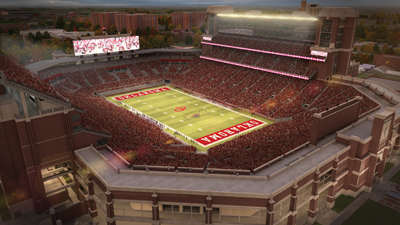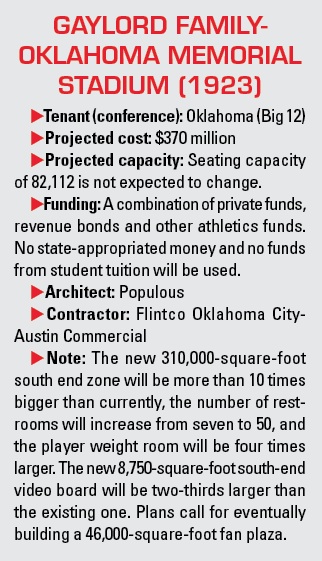Joe Castiglione views the renovation of Oklahoma’s football stadium as the practical solution to fit the needs of Sooner Nation.
Knocking on the door of $400 million is obviously a ton of money to spend for upgrading 92-year-old Gaylord Family-Oklahoma Memorial Stadium, but it beats the alternative for building a new facility elsewhere at double the cost, according to Castiglione, OU’s athletic director.
As part of the stadium’s master plan, Populous, Oklahoma’s architect, ran some cursory numbers to build a new 85,000-seat facility and came up with an estimate of between $700 million and $800 million, Castiglione said. The estimate covered all of the infrastructure costs required to create a site for a new stadium.
 |
The project is targeted for completion in 2017.
Photo by: Populous |
After weighing the costs for both options, a major renovation got the thumbs-up over new construction for a project financed privately by the university.
“We didn’t have a site selected but we did our due diligence to give us the right information to make a comparison and we felt [renovating] was absolutely the best way to go,” Castiglione said.
“The other value of our current stadium which is really important is the fact that it’s been in the center of a gorgeous campus and the site of many memorable experiences,” he said.
Those memories include the exploits of five Heisman Trophy winners and legendary coaches Bud Wilkinson and Barry Switzer leading national championship teams, as well as current coach Bob Stoops. There is value in keeping the memories alive where they took place, Castiglione said.
“There’s still something about these so-called cathedrals of college football … and we’re fortunate to have one of them,” he said. “We’re just doing what we collectively believe is in everybody’s best interests to enhance it, for those that will use it in the decades ahead.”
After deciding to renovate, OU officials set two goals for the project. First, to develop a world-class venue for the
football program by upgrading the team’s support facilities in the stadium’s south end. Those spaces cover a new weight room and equipment room, other team areas and coaches offices, and a relocation of athletic department offices from the north end. At the same time, they want to create an unforgettable fan experience by expanding concourses and building new restrooms and concession stands, and a new team store.
“The stadium is home to both endeavors … so in some ways one can’t be done without the other,” Castiglione said.
The school has committed to raising a minimum of $150 million before construction begins. The project is targeted for completion in 2017.
The current project follows a significant renovation completed a decade ago. In 2004, Oklahoma finished a two-year, $75 million expansion that replaced all stadium seating, added two levels of suites on the east side and expanded club spaces, among other improvements.
However, there are still structural parts of the stadium nearing 100 years old that must be replaced and the newest upgrades will address those issues, Castiglione said.
Some improvements are small in scope and don’t produce revenue but they make a difference for fans to improve their experience. For example, some areas don’t have handrails in the aisles, an important safety feature requested by fans during Oklahoma’s market research.
To install those handrails and get up to code requires OU to widen aisles in the seating bowl, which in turn leads to a reduction of one to two seats per row, Castiglione said.
In other cases, smaller 14-inch-wide seats in pockets of the stadium will be replaced by larger seats to match the standard 18-inch seat width, which leads to a further seat reduction.
Again, not a sexy piece of the renovation and it presents a challenge considering the demand for Sooners football.
“We’re nearing 100 straight sellouts and there isn’t anyone in the stands wanting to readily give up their seat, so we have to find a means to relocate them,” Castiglione said. “We’re working through this in a very systematic sort of way to address those priorities.”
The stadium currently seats 82,112. The new number remains a moving target pending final design and donors’ demand for the mix of new suites, loge boxes and club seats that serve as the financial engine driving the project.
The 14 Founders Suites, the largest in square footage and most expensive of the new premium inventory, will anchor the west sideline at midfield, modeled after similar high-end suites at Baylor and TCU, two Big 12 counterparts.
In addition, 22 regular suites are planned for the south end zone as part of the redevelopment. The total number of club seats across all areas of premium seating will almost double to about 10,100 in the reconfigured facility, said Larry Naifeh, OU’s executive associate director of athletics.
School officials see the renovations extending the stadium’s lifespan for another 50 to 75 years. In the end, they believe that taking a sustainable approach fits better with their educational mission, keeping in mind Sooners fans ultimately pay for the upgrades through their donations and ticket purchases.
“In a world where we see sports facilities being put forth before people as a visionary approach and getting the municipalities to support it … only to dwindle to a point where a new facility has to be built 20 years later … that’s not the approach college athletics should ever take,” Castiglione said.





